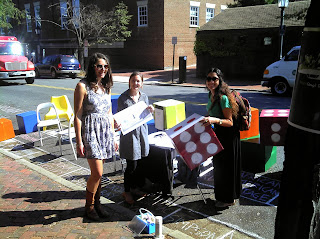Happy PARK(ing) Day
everyone! Go out and claw a piece of
public space out of the steel clenches of an automobile!
 | |
| Landscape students from the WAAC setting up their space |
From my window at the WAAC I can see a few of our intrepid landscape students setting up
their “PARK-opoly” game in two parking spaces on South St. Asaph Street. They’ve already weathered some predictable
snide asides from the NFA—the No Fun Allowed—types. “Children can’t play in the street!” “You
know, parking is really valuable here.”
Oh boy.
The Washington Post Magazine just ran a series of articles
last Sunday looking at the future of Washington (which is looking so bright, I’m
already wearing my shades) and one
of them focused on the care and board of these ubiquitous metal
beasts. Harriet Tregoning, the city’s
world-class planner, said “Five to 10 years ago, if some aliens had taken a
picture from space they would think our city was inhabited by steel creatures
with gushy insides. Creatures that slept most of the time.”
PARK(ing) Day is a
clever way to open our eyes to all the other things we could do with the
roughly 200 square feet that we’ve just handed over to these beasts and their
servants. Danish urbanist Jan Gehl tells
a great story of how Copenhagen gradually wrestled its streets from automobile
hegemony by subversively taking away a few spaces every night. Alexandria and the District have already
bulbed out sidewalks at intersections; the District has usurped some parking spaces
for Capital Bikeshare docks. The possible next steps are being constructed
all over the world today, and there are probably a few right near where you
work.
Henri Lefebvre wrote in the late 1960’s about the “right to
the city,” the right of all people, not only those with capital or power, to be
present and visible in the city. His is
a forecful, if difficult to read, argument for fighting for the public in
public space. His theories underlined
the recent Occupy movement, with their resistance to the excessive power of
global capital to shape our cities. But
we’ve sat passively by, in the passenger seat so to speak, for decades and put
the convenience of car and driver above all else in urban planning and policy. Our cities long ago lost the fine grain that
comes from the height and pace of a walking person. No more is the human as measure of all things; now it's the SUV. But, as Tregoning
makes beautifully clear, there’s absolutely no reason why it should always be
so.
So, if you walk by a new little café, garden, or play space,
stop and enjoy it. See how good it feels to occupy that space. You have a right to it.

No comments:
Post a Comment